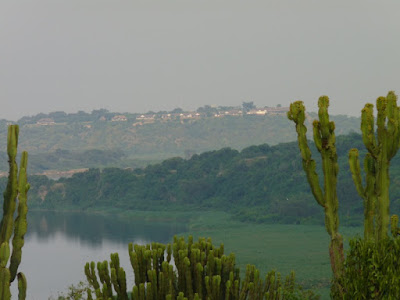It's been far too long since I offered a post about Africa (and even longer since I've been there!). I can rectify the former more readily however.
Queen Elizabeth National Park was declared in 1952, and enlarged soon afterwards. It covers 198,000 hectares of rolling grassy and wooded plains in the far south-west of Uganda, some 380kms south-west of Kampala. It lies between Lakes George and Edward - the border with Democratic Republic of the Congo runs through Lake Edward.
 |
| Queen Elizabeth National Park marked (somewhat crudely!) in red. |
 |
| More detailed park map. (Courtesy Safari Bookings.) |
For a while the name changed to the arguably more appropriate Rwenzori National Park (the Rwenzori Mountains provide a backdrop to the south) but curiously it changed back again more recently; I can't get the details, but I suspect it coincided with the declaration of the nearby Rwenzori Mountains National Park in 1991.
We stayed at the very nice Mweya Lodge on a peninsula between Lake Edward and the Kazinga Channel which joins the two big lakes. There are several other lodges and camps, as on the map above, but I have no experience of them.
 |
| Approaching Mweya Lodge, above and below. The euphorbias in the foreground are typical of the park vegetation. |
 |
| The view from the outdoor restaurant, over Lake Edward and the Kazinga Channel, is superb. Slender-billed and Yellow-backed Weavers work the tables, hoping for left-overs. |
 |
| Dawn views, above and below, over Lake Edward. |
Meals were good, though I confess I didn't try this one.
The lodge grounds are excellent for an array of wildlife - birds, mammals and reptiles.
 |
| Yellow-backed (or Black-headed) Weavers Ploceus melanocephalus are bold and ubiquitous. This seems to be a male moulting into (or out of) breeding plumage. |
 |
| Swamp Flycatchers Muscicapa aquatica are also prominent here; they are found right across central Africa. |
 |
| Grey-capped Warblers Eminia lepida are not nearly as easy to see, though their lovely song is often present. They are the only member of the genus, in the cisticola family. |
 |
| Warthogs Phacochoerus africanus appreciate the watered grounds, where they play havoc with lawns by digging for roots and tubers. This kneeling posture while foraging is typical. |
 |
| As can be seen here, they are not at all reticent about approaching the cabins! |
Another mammal moves through the grounds en masse too, hunting smaller animals attracted by the amenities offered by the lodge grounds, with a particular fondness for beetles and millipedes. The latter is an unlikely delicacy as many species exude noxious chemicals for protection. They will however eat pretty much whatever comes their way, including frogs, lizards, small snakes, birds and eggs.
 |
| Banded Mongooses Mungos mungo are found widely across central and eastern Africa. Unlike most mongooses they habitually forage in groups of up to 40. |
The spectacular Blue-headed Tree Agamas Acanthocercus atricollis loll around the grounds too, though their apparent sloth is in fact an established hunting strategy - they wait for their prey (especially grasshoppers, ants and beetles) to come to them. Like the Banded Mongooses, they too can cope with bitter millipede chemicals.
I don't normally do promotions for establishments, but Mweya really is an excellent place for wildlife and scenery. Obviously however there is much more to the park than the lodge, and too much for just one posting; indeed I've realised that I'm going to need three! So, next time I'll look at life across the plains, and in a third installment I'll share a most remarkably wildlife-rich boat trip, along the Kazinga Channel.
BACK ON MONDAY; you can find it here









3 comments:
What on earth do you think they thought they were saying on that menu? I wondered if someone was inserting random English words as a joke, to see who noticed. Usually with mangled English on menus you can work out what the word ought to be.
That's a problem that has bothered me for years Susan - I assume it's referring to a herb or spice, but I can't think laterally enough to work out their intent. I was hoping you or someone could enlighten me!
I have sought advice from a Ugandan lady I worked with in the UN. Here is her reply.
"I've read the blog and, for the life of me, can't figure this one out! I don't even know what a rounder chicken is. Probably not many people would order this."
One issue with languages in Uganda is that they don't have (or at least didn't have in 2002) an official language. There are 64 tribal languages (plus English) used in country so the possibility for confusion is immense.
In context I wonder if it isn't mayonnaise: the stuff in squeeze bottles often looks like hair cleanser. I would have bought a burger to see what arrived. (At current exchange rates they were only asking $4.85 which isn't bad value for a mzungu meal.)
Martin
Post a Comment